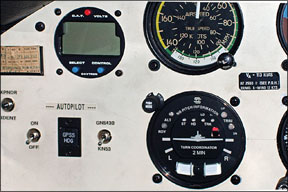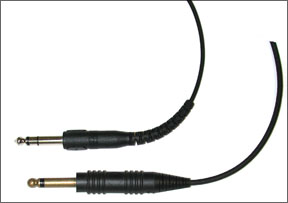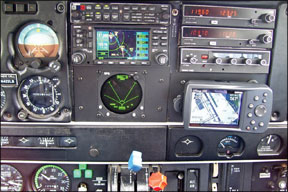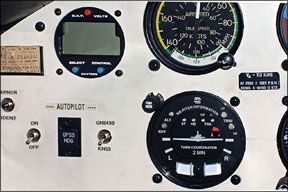A casual stroll through a modern avionics shop can be as dangerous as a Harley-Davidson fanatic visiting the accessory department at the dealership. Its easy to grin like a kid and convince yourself that you need one of each. To keep the lust factor in check, you’ll need to prioritize and decide which new gear will offer the most utility given the investment. Weve assembled our list of the top five upgrades worthy for consideration based on value and capabilities. These arent in any order of preference. While each wont come without an impressive invoice, we don’t think any are over the edge for most light aircraft. Just beware of add-on accessories that can add to the bottom line faster than you can say “Ill take it.”
PS Engineering PMA8000B
In our view, the most important system in the cockpit, and the starting point for all avionics upgrades is the audio control system. Its no surprise that a lacking audio system can affect the safety of flight. A friend who owns an old Seneca recently had a total audio system failure while in solid IMC. His old, portable comm transceiver was a great help on the approach that would be near minimums – until the batteries quit at the outer marker.
His first phone call on landing was to the control tower and the second was to the avionics shop to schedule an audio upgrade, replacing his ancient Narco CP136 switching panel.
As with nearly all modern audio control systems, the PMA8000B is a combination audio selector/intercom system that can be interfaced with up to six seats. It has pilot and crew isolation, integral marker beacon, a cell-phone interface and plenty of unswitched inputs for audio alerts. We reviewed the PM8000 in the June 2006 issue of
Aviation Consumer and proclaimed it top-dog. Its rich in cabin entertainment control and distribution, a slick feature that many owners demand given the popular satellite radio craze and other digital music devices.Audio upgrades are labor intensive, and a sizeable portion of the cost represents labor. For example, new headset plug-ins are often required, and that gets into interior removal for routing the audio harnesses throughout the cabin. All the radios in the avionics stack usually come out as well. For aircraft that havent been upgraded in years, that can be a lot of new wire.
you’ll need to decide if you want to install stereo audio jacks. Most modern headsets have a stereo/mono selector switch, but lower end models might be mono only, creating a problem when you plug them in. Now might be a good time to upgrade to ANR headsets for the ultimate in audio quality. Given the flawless audio gained from the PMA8000B, we think the interface is shortchanged with passive models.
Be sure to spec push to talk switches with the upgrade because some shops view yoke-integrated transmit switches as optional. If the aircraft doesnt have drilled yokes-that is no drill holes for mounting integrated switches, your only option might be a portable switch that can be hardwired to the jacks. With enough effort,

this can be a clean install despite the presence of dangling coil cords that attach to the switch.
As noted, the PMA8000B has the ability for dual entertainment input, so if you have a Garmin GPSMAP 496 or 396 with XM Radio for example, it can be interfaced directly to the panel for listening to XM Radio. Then there is the remote input jack for plugging in a portable music devices like an iPod, MP3 player, CD player, etc. Confirm with your installer where these interfaces will go in the cockpit.
A complete PMA8000B retrofit in a four-place aircraft including entertainment input and push-to-talk switches should run $3000-$3500 installed, including equipment. Fancy music switching could add to this. If a new interior is in your plans, install the audio system first so the audio stations can be integrated within the new interior during assembly.
S-TEC 30 with GPSS
Autopilot and flight-control equipment upgrades are usually high on the owner wish-list. For aircraft that spend a lot of time in weather, we think they are imperative. The S-TEC 30 is a dual-axis system with lateral steering and altitude hold. An appropriate directional gyro or HSI will be required for the heading command function. The S-TEC system is compatible with many existing heading systems. This is good news if you remove an old Century or Cessna system since you can likely retain the existing gyro if its equipped for heading output drive. Be sure the gyro is in good health.
The System 30, as with nearly all S-TEC autopilots for light aircraft, is rate-based with an electric turn coordinator commanding near-standard-rate roll input. The controls for the autopilot are self-contained on a function shaft of the turn coordinator, while autopilot mode annunciation is integrated on the face of the unit.
Autopilot mode control can also be accomplished with remote mode switches mounted on the pilots control yoke, as can autopilot disconnect switching. Some yokes cant accommodate these switches so the installing shop will need to install

an optional switch housing which attaches to the yoke. This drives the costs up, but its a worthwhile effort in our view.
The $1700 ST-901 GPSS digital steering system is a worthy option to the System 30 if the aircraft has a Garmin GNS 430W or GNS 530W. Since these navigators output guidance through a hold and procedure turn, GPSS allows for hands-off automation and approach course capturing. Its important to understand that the System 30 does not have glideslope capturing so it wont couple to the vertical portion of ILS or WAAS GPS precision approaches. you’ll need to step up to the flagship 55X system for this capability, which is a stretch for many budgets.
There is a factory step-up program in place, where lower-end S-TEC autopilots can be upgraded to higher-end systems, which supports the S-TEC claim of a “building block” platform. This involves replacing the flight computer and adding additional servos and other components that are required for a step-up system. S-TEC makes it clear that the removed components must be returned to the factory in keeping with the upgrade program.
You can expect a System 30 with the GPSS steering option to yield an installed price of around $13,000. We feel this is a decent value given the capabilities and utility afforded by a dual-axis autopilot with nav tracking ability.
GTX330 Mode-S
Were not surprised by the number of pilots who are increasingly-concerned with running into other aircraft (us included). Frankly, we feel vulnerable when we fly without a traffic minder. TIS, for Traffic Information System, is a key feature of the GTX330.
Despite the 2005 announcement of a gradual discontinuation of the secondary surveillance radar that transmits the TIS traffic data, sales of the GTX330 have actually surged, says Garmin. The phase-out of some of these radar sites will eliminate TIS coverage in some areas, but coverage remains plentiful in congested areas where theyre needed the most.
If you can live with the limitations of the altitude-restrictive TIS technology (for airports where the radar facility isn’t co-located, expect to drop out of TIS coverage somewhere around pattern altitude) and the prospect of a total cancellation someday as ADS-B technology becomes widespread, we still think its a worthy investment given the benefits of TIS right now. There is hope that existing Mode S TIS transponder will fit in with the anticipated ADS-B technology.
As for the GTX 330 upgrade, the L-Band antenna system represents an integral part of the installation. We find that best performance is yielded with a blade-style antenna and low-loss coaxial antenna cable. In some aircraft, this antenna work can present considerable amounts of tear-down, and the cost that tags along. Antenna and cable replacements can easily add $500-$1000 to the bottom line depending on the airframe. A new altitude encoder can add another $500.
The GTX330 has an audio output for traffic callouts, and this will need to be wired into an auxiliary input of the audio panel. There is even a basic altitude buffering feature, where the box will call out a “leaving altitude” message if you wander off a selected altitude. Pictorial traffic alerting is presented on the screen of nearly all modern MFDs and can even be displayed on the Garmin GPSMAP 496 and 396 portable GPS units.
We like the pressure altitude readout on the display of the GTX330 (and on the lower-end GTX327, too) as you are always aware of the status of the altitude encoder. There is even on-screen count-up/count-down timer. If you forget to take the transponder out of standby on departure, the unit will automatically go to altitude-reporting mode if connected to the GNS 430 or 530 as the unit senses groundspeed on the takeoff roll. On landing, when groundspeed drops below 35 knots it goes back into standby. Slick.
A basic GTX330 installation will run around $4800 using the existing antenna system. Compare this to we’ll north of $10,000 for an entry-level traffic alerting system, like the Avidyne TAS 610. Given the reliability, features, and traffic minding capabilities we think a GTX330 installation is worth the investment.
Garmin GNS 430W
The number of GNS 430 units sold, almost 10,000 since 1999 or thereabouts, summarizes the success of the GNS 430 and supports the argument that the box fits nearly any application. From the smallest of trainers to some biz-jets, the GNS 430 series, including the current WAAS-equipped GNS 430W is considered the most successful piece of avionics since the King KX170B. For aircraft that need a

replacement nav/com and IFR GPS, the GNS430W makes the most economic sense in our estimation. If you tally the cost of a new nav/com with glideslope and a stand-alone IFR GPS, you’ll likely exceed the cost of a GNS4 30W installation, which should be around $13,000 with a new GI106A nav indicator.
Its prudent to stress that GNS 430W physical installations arent getting any easier, since the new WAAS GPS engines seem to be far more sensitive to RF noise and interference than the legacy receivers. Over the years, weve put our eyes on GNS 430 installations performed by amateurs. This wont fly with new WAAS boxes. Placement of the GA35 GPS antenna on the airframe is critical, as is the use of low loss twin-shielded coaxial cable.
The GNS430W has AML-STC installation approval, so if your model is on the list FAA field approval wont be required. Thats a welcome bonus and a time-saver.
There will be additional approval required, however if you have a Cessna with a 400A autopilot as some earlier models do. Since the coupling of the WAAS GPS vertical glideslope to the 400A system isn’t included in the STC and supporting installation manual, approval will be difficult and time-consuming. Garmin suggested that the 400A system, as we’ll as some other new interfaces, might be included in a future revision, but for now its up to the shop to obtain a blessing for the interface.
If not equipped, you should count on the installation of an avionics cooling fan which will add roughly $500 to the package. We think installing a GNS430 or any new avionics without a cooling fan is foolish. Similarly, an avionics master switch and rework of the electrical bus might be in order, for an additional $500 or so. For some aircraft, including most older Beechcraft Bonanzas and Barons where the radio stack is displaced far from the pilots instrument panel, a remote GPS mode annunciator panel will need to be installed, adding to the interface.
You can save $1000-2000 on equipment with the GNS 420W (no nav) or the GNS 400W (no nav or com), but with panel space already tight in most light singles, the complete 430W install is the overwhelming choice.
When an aircraft hits the used market, the presence of a GNS430 in the panel surely makes it more desirable. When learning to fly instrument procedures, the GNS430 might make your life a whole lot easier. A new GNS430W installation wont be cheap, but we think it represents an excellent value.
Semi-Portable GPSMAP 496
In our recent budget IFR upgrade article in the April issue of
Aviation Consumer, we concluded that the GPSMAP 496 is a wonderful alternative to a panel-mounted MFD or integrated GPS/map. In some cases it offers more than the panel-mounted alternative. With integrated XM Weather and XM Radio, SafeTaxi surface charting and WAAS GPS, the GPSMAP 496 is clearly up to the task of providing sole-means navigation to the VFR pilot and is a huge help for IFR pilots. But the GPSMAP 496 is still a portable unit, and the associated power wires and antenna cables dangling in the cockpit is far from convenient.The solution? Perform a semi-permanent installation on the instrument panel while retaining a portable status. This will require some custom sheet metal work, essentially fabricating a mount to attach to the surface of the panel (note we say surface and not into the panel). Garmin offers a power/data interface cable for grabbing power off the electrical bus so you wont have to run on batteries. The interface portion of the cable can be connected to most Garmin panel-mounted units for waypoint and flight plan overlay.
XM Radio can be interfaced to an intercom entertainment input by utilizing the 496s line output port. This can be accomplished by using a standard 1/8-inch stereo patch cable and plugging into the entertainment input jack or hardwiring directly to the intercom or audio panel. Some installations might require a noise filter, since the charging system and other annoying noise can sneak into the circuit.
Including the cost of the unit, a semi-portable setup installation can likely be had for we’ll south of $4000. Of course, there are many other portable systems out there to consider with varying integration options.
Conclusion
We cant recall a time where the avionics world offered so many diverse options for upgrade. There is an upgrade available for nearly all budgets, all requiring some level of sacrifice. Just the same, many folks take the plunge into aircraft ownership with plans for big avionics upgrades-until reality sets in and the bank statements prove that ownership is far from cheap. This is why you need a backup plan in case you cant afford that flagship autopilot or big-screen MFD.
The way we see it, choosing any or all of our picks here will offer great alternatives to the over-the-top upgrades you once thought you could afford.
Larry Anglisano is
Aviation Consumers avionics editor.

